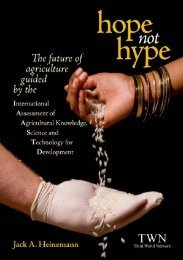gene Flow: Implications for Crop Diversity and Wild Relatives
gene Flow: Implications for Crop Diversity and Wild Relatives
gene Flow: Implications for Crop Diversity and Wild Relatives
- No tags were found...
You also want an ePaper? Increase the reach of your titles
YUMPU automatically turns print PDFs into web optimized ePapers that Google loves.
<strong>and</strong> they do not pose a concern, yet crop-to-crop <strong>gene</strong> flowoften is a concern. The possible dispersal range of reproductivepropagules (i.e. pollen) is dependent on many different climatic(including wind, humidity, temperature, etc.) <strong>and</strong> biologicalfactors (height of plant, size of propagule, natural outcrossingrates, etc.), but human dispersal can also broaden this range.Second, in order <strong>for</strong> <strong>gene</strong> flow to occur, there must be anoverlap in phenology (flowering <strong>and</strong> fertility times) betweenthe transgenic crop <strong>and</strong> recipient population. <strong>Flow</strong>ering timesmay be affected by ecological <strong>and</strong>/or biological factors insome circumstances, leading to partial or total reproductiveisolation among neighbouring populations. Third, any matingbetween a transgenic crop <strong>and</strong> a l<strong>and</strong>race or wild relative mustproduce fertile <strong>and</strong> viable offspring. Reproductive barriers tointrogression are strong, especially where ploidy number (genomiccopy number) differs between domesticated <strong>and</strong> wild croprelatives (Jenczewski et al. 2003). This may only occur in limitedscenarios. Plants that normally are only self-compatible, i.e. havethe capacity to only mate with itself, also represent a type ofreproductive barrier. Fourth, the offspring of the new transgenichybridplant must also be viable <strong>and</strong> fertile to some extent, <strong>and</strong>a lack of survivors means that any potential <strong>gene</strong> flow wouldcease at this point. Yet even a low level of fertility can lead tofully viable populations in subsequent <strong>gene</strong>rations, as wouldbe the case with backcrossing (mating ‘back’ or again, with theparent population) into the wild progenitor populations.When these four conditions are met, trans<strong>gene</strong> flow is likely.In some of these cases, offspring will have reduced fitness, orproduce sterile (unviable) seeds. In other cases they will haveimproved vigour (Singh et al. 1995; Hauser et al. 1998) <strong>and</strong>fitness, yet the advantages may reduce or reverse over time.Thus, there must be a minimum level of fertility in order <strong>for</strong>the recipient population to maintain the trans<strong>gene</strong>(s) <strong>and</strong> surviveto the next <strong>gene</strong>ration. Lastly, it should be mentioned that the5
















